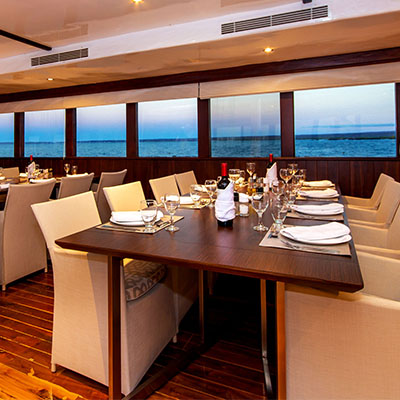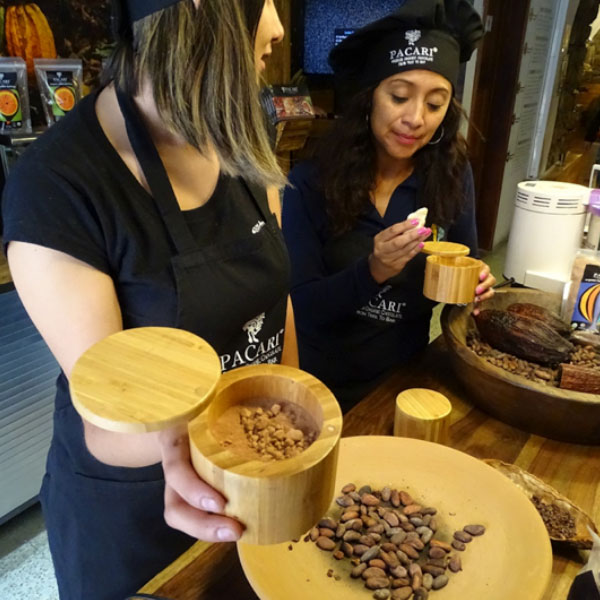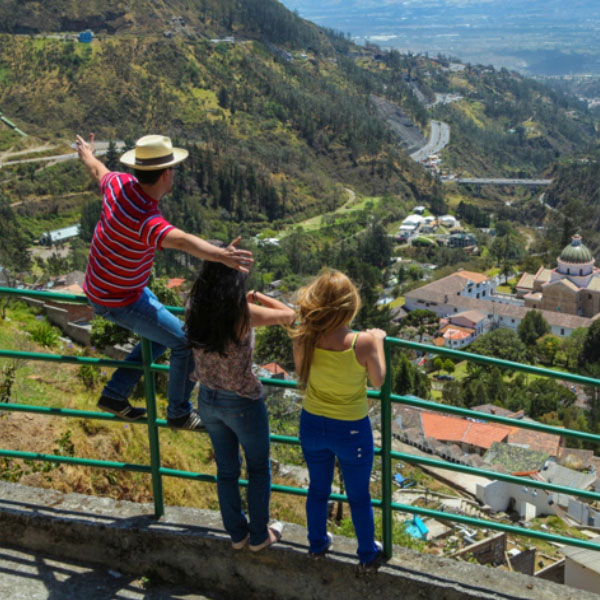GTEG-111 – M/Y GALAPAGOS ODYSSEY CRUISE ITINERARIES
SIX DAYS / FIVE NIGHTS (ITINERARY “A”) – TUESDAY TO SUNDAY
Detailed Itinerary
DAY 1: TUESDAY – ARRIVAL IN GALAPAGOS ISLANDS
San Cristobal Island
This morning you will fly from Quito or Guayaquil to San Cristobal Airport. After welcome, check-in, lunch, briefing and the safety-drill we leave to visit the Galapagos giant tortoise breeding center on Colorado Hill. This and similar breeding centers on Santa Cruz and Isabela have been created to rescue these endangered giants by collecting their eggs in the wild, reproduction in captivity and repopulation once the hatchlings are big enough and less vulnerable for predators. This center works with the local subspecies of Galapagos giant tortoises. Around the large corral, there is also an interpretive botanical trail and an interesting visitor’s center. Here the natural history of the local giant tortoises is explained including the relationship and evolutional differences between these and other subspecies.
On the trail you can spot songbirds as well, such as yellow warblers, endemic Galapagos large-billed flycatchers and the Chatham mockingbird. Before dinner your guide will conduct his first briefing followed by the Captain’s welcome cocktail. (even ‘more’ endemic, while unique to this island alone), that put Darwin on track of his evolution theory
Meals: Lunch, dinner
DAY 2: WEDNESDAY – GALAPAGOS ISLANDS
Española Island
Suarez Point & Gardner Bay
Española is one of the crown jewels of the archipelago, and offers all that you might expect from Galapagos; it’s a real bird watcher’s and photographer’s dream.
AM: Suarez Point
Huge waves bang onto the southern basaltic cliffs of Suarez Point, forming a spectacular blowhole, where the water sprays meters high into the air. Take your time for a meditative break in silence on this emblematic viewpoint, and convert this unforgettable moment in a lifetime experience.
Española marine iguanas become bright red with a turquoise-colored crest and legs at the start of the breeding season. Hood lava lizards the largest of the 7 endemic species in the islands, mockingbirds that have become carnivorous! Waved albatrosses soaring most time of their lives far out at sea and just come back to land to breed and nurture their chicks. This spectacular seabird is the only tropic albatross and it is considered a critically endangered species. It just breeds on Española Island. During their mating you will be able to admire their synchronous courtship dances that include bowing, whistling and even a stylized form of ‘sword fighting’ with their bills! Suarez Point is also a massive breeding site for Nazca and blue-footed boobies, swallow-tailed gulls and red-billed tropicbirds. During the food-abundant garúa-season you can admire amusing courtship dances, mating, breeding, emerging from the eggs, nurturing or first flight-attempts. Passing seabirds and marine iguanas give you the feeling of being in a nature documentary!
PM: Gardner Bay (Española)
The striking white beach at Gardner Bay is an important breeding site for Pacific green turtles. But without doubt its main attraction is the Galapagos sea lion colony. Females stay year round in this nursery, suckling their pups up to an age of 3 years. During the mating and breeding season the colony becomes even more populous. The strongest bachelors and elder males return from their secluded bases and start again to conquer and defend a part of their territory.
Meals: Breakfast, lunch, dinner
DAY 3: THURSDAY – GALAPAGOS ISLANDS
Floreana Island
Devil’s Crown, Cormorant Point, Post Office Bay & Baroness Lookout
Before daybreak we have dropped the anchor at the Northern cape of Floreana, known as Cormorant Point. Nearby are several tiny islets, which count with some of the most fantastic snorkelling and scuba dive-sites, such as Devil’s Crown and Champion. The historical place of Post Oce Bay is also excellent for sea kayaking. Floreana determines the southern border of Galapagos and gives the sense to be somewhere at the end of the world. Its fresh water spring on top made it the rst of four inhabited islands in the archipelago, although you won’t notice the present settlement Puerto Velasco Ibarra (150 inhabitants).
Program After breakfast the inatable dinghies will bring you to the rocky rim of Devil’s Crown, which is located just outside the bay of Cormorant Point. If fantastic deepwater snorkelling (with sometimes stronger currents) is not your thing or if you rather prefer birdwatching, alternatively you can make a great ride by inatable dinghy (landing is prohibited on these marine visitor’s sites). After a snack we make a wet landing on the greeny beach of Cormorant Point. From here you will follow the sandy path to the other, powdery sand beach of the peninsula, which has been formed by a lava tongue (Easy Level; about 1,5 km, 1 mi). En route you can observe the American amingo lagoon from dierent viewpoints and perspectives. After a short displacement to Post Oce Bay and lunch, you can post your holiday greetings in the traditional barrel just behind the beach (wet landing), which is also a comfortable place to relax. Next you can explore the submerged crater rim that surrounds the neighbouring bay of Baroness Lookout in your own pace by sea-kayak, or by inatable dinghy. Around midnight we will navigate about 5 hours Northeast to the extraordinary island of Santa Fé.
AM: Devil’s Crown
With no less than five sea currents, the marine reserve is even more diverse than the archipelago above sea level. Devil’s Crown is one of the best snorkeling sites and one of the highlights of your cruise. The depth and very transparent waters of this snorkeling site feels like plunging in a huge tropical aquarium, swimming amidst schools of thousands of brightly colored tropical fish such as yellowtail surgeon fishes and king angelfishes. Sometimes a Pacific green turtle or Galapagos sea lion is passing. On the bottom you can distinguish resting whitetip reef sharks, different species of ray and starfishes. The inner walls of the crater rim are coated with coral formations and protected against the surf. Above sea level the dramatic decor of the jagged crater rim provides living space to lots of coastal birds, including lava gulls, blue-footed and Nazca boobies, brown pelicans, and red-billed tropicbirds, which look for protected nesting places in caves or ledges under a rock overhang.
AM: Cormorant Point
This is one of the best places in Galapagos to observe American flamingos and other aquatic birds such as pintails (or Bahama ducks). Its salty lagoon houses a breeding colony of dozens of these elegant and exotic, but nervous waders. The peninsula of Cormorant Point forms the extreme north cape of Floreana, which is pockmarked by numbers of smaller volcanic cones and covered by tropical dry forest (predominantly Palo Santo). At the landing beach you will be welcomed by a small Galapagos sea lion-colony. The green sand on this beach contains a high percentage of glassy olivine crystals that have been blown out by the surrounding tuff cones. The beach on the southern side is covered by finer white corals sand which has been pulverized by parrotfishes grinding the calcareous skeletons of living coral. In the surf you can recognize schools of sting rays that love the sandy bottom to hide themselves. During the first months of the year Pacific green turtles come ashore to bury their eggs. And, please don’t expect to spot the flightless cormorant at Cormorant Point, This emblematic example of evolution lives exclusively in the remote west of Galapagos on Fernandina and Isabela.
PM: Post Office Bay & Baroness Lookout
Post Office Bay is one out of three nearby visitor’s sites on Floreana’s northern coast. Bring your postcards and post them in the peculiar traditional barrel on this historic site. These might arrive home quicker than you! The barrel commemorates an improvised mail service that was set-up for communication between British 16th century whalers and poachers. Returning vessels picked-up letters from the barrel for home delivery.
Continuing by dinghy to Baroness Lookout you will follow the graceful arm around the sheltered bay to the entrance of a submerged tuff cone. Alongside you can spot Galapagos sea lions, Pacific green turtles, golden cow nose rays, and you might even catch the surprising sight of a Galapagos penguin! After landing you can climb the miniature basaltic cone of Baroness Lookout admiring one of the most striking panoramas of Galapagos. The turquoise and ocean blue waters merge with all year lushly red mangroves and basaltic rocks. This viewpoint was the favorite spot of one of the first colonists, Baroness Eloisa von Wagner Bosquet.
Meals: Breakfast, lunch, dinner
DAY 4: FRIDAY – GALAPGOS ISLANDS
Santa Fe and South Plaza islands
AM: Barrington Bay (Santa Fe)
Practically every animal on the extraordinary island of Santa Fe is unique; endemic to Galapagos, or even to this island alone and therefore extremely vulnerable! Apparently evolution has had enough time and isolation to create the wonders that will surprise you nowadays. And indeed, geologists have determined that Santa Fe is the remnant of probably the most ancient volcano of Galapagos; the 850 feet high hill is all that remains from its former cone.
Almost every visitor of Santa Fe would like to get a glimpse of the rare Barrington land iguana. But this pale version is not as easy to spot as its modelling counterparts on South Plaza. This one sometimes asks for an adventurous search, rather untypical for Galapagos; however, there are other times that surprisingly is waiting for you next to the path. Whether you spot it, or not, you will keep going from one surprise into the other. Your experience starts already before anchoring at Barrington Bay, when the contours of its bizarre giant opuntia cactus forests become distinguishable. These largest cacti have extremely thick trunks and can grow over 33 foot tall!
You will land right into a Galapagos sea lion colony on the beach, attentively being stared by surprisingly tame Galapagos hawks. Snorkeling in the paradisiacal bay gives the opportunity to amplify your growing spotting list with (harmless) whitetip reef sharks, spotted eagle rays and lots of colorful tropical reef fish. Maybe a curious Galapagos sea lion is willing to play with you!
PM: South Plaza Island
Although in sight of Santa Cruz Island, the southern of both Plaza islets is quite different and diverges from all other sites in the National Park. At the same time it is so typical Galapagos, with its sharp contrasts, amazing diversity and with high concentration of wildlife. It is one of most popular, not to be missed islands, and definitely another highlight of your cruise.
There are several large Galapagos sea lion colonies here and this islet is best place to encounter the endemic Galapagos land iguana. Watch your step and don’t stumble over one of them when the equally bizarre giant prickly pear cactus-trees distract you! These reptiles are very patient models and extremely photogenic with strikingly yellowish or saffron-colors. On South Plaza the land iguanas remained somewhat smaller because of overpopulation and severe food competition. It is incredible to see how cactus spines don’t harm their leathery tongues while chewing the pads, flowers and fruits. Beware as well for some unique hybrids, a result of crossing a male marine iguana and a female land iguana.
South Plaza has two sides which provide it with complete different ecological niches and wildlife. At the upper rim of this seismic uplifted formation you will learn about its windy, wild side, where dazzling cliffs cut off abruptly the gentle slope. About 75 feet downwards powerful waves splash against the foot of these massive walls. Sun basking marine iguanas have become talented rock climbers equipped with strong claws.
Clouds of petrels, storm petrels and shearwaters make spectacular flights and sometimes appear to walk on the waves. Take your binoculars and don’t miss the red-billed tropicbird with its graceful long tail and spectacular mating fights. These cliffs are also a nesting place for the endemic swallow-tailed gull, the most beautiful gull in the world. Its neatly lined eyes are perfectly adapted for its exceptional night fishing habits. From bird’s-eye perspective it is even possible to discover schools of surgeon fishes, Galapagos mullets and if you are lucky even a jumping manta ray!
Meals: Breakfast, lunch, dinner
DAY 5: SATURDAY – GALAPAGOS ISLANDS
North Seymour Island & Bachas Beach, Santa Cruz Island
AM: North Seymour
This islet is one of most visited sites with abundant bird life. An easy circular path takes you through the archipelago’s most extensive colonies of blue-footed boobies and frigate birds. At the start of the breeding season adult frigate bird males blow up their vivid red pouches to impressive football-sized balloons. This is one of the few spots where you can compare the magnificent and the rarer great frigate bird breeding next to each other. The even more popular blue-footed boobies show their cute courtship rituals, in which their remarkable feet play an important role. Moreover you can spot lots of other seabirds, such as brown pelicans, red-billed tropicbirds, endemic swallow-tailed gulls and seasonally even Nazca boobies. Between the shrubs you might sight a Galapagos land iguana.
North Seymour originally did not count with land iguanas, but in the 1930s an eccentric American millionaire moved the last generation from Baltra, and saved them for starvation and afterwards the breeding program at Charles Darwin Research Station turned into a big success.
PM: Bachas Beach (Santa Cruz)
Strolling along its coastline, the blinding white Bachas Beach appears full of natural life. The turquoise bay and the symmetrical tuff cone-islet of Daphne Major pull your eyes to the horizon. Much closer, in the intertidal zone impressive sparkling orange colored and heavy-armed Sally light foot crabs run around the dark basaltic rocks.
You will reach a brackish lagoon in the dunes, with different species of wade and shore birds, including gracious and noisy black-necked stilts, white-cheeked pintails (or Bahama ducks) and hunting herons. Migratory aquatic birds that winter in Galapagos, such as whimbrels, also frequent this pond. As soon as the water level drops and becomes saltier in the dry season, you might even encounter some American flamingos tirelessly filtering water to catch shrimp and algae!
These two quiet places along the remote north-western coast have become the preferred nesting site for Pacific green turtles on this main island of Santa Cruz. Females wait for high tide at night before crawling ashore, resulting in an unnoticed, safer and less exhausting effort. In the sunny months (November-February) the powdery coral sand becomes a hot greenhouse, and as soon as the eggs hatch, lots of predators arrive to catch their prey.
Meals: Breakfast, lunch, dinner
DAY 6: SUNDAY – DEPART GALAPAGOS ISLANDS
Baltra Airport
After breakfast it’s time say goodbye and disembark the yacht. Your guide and crew staff will accompany you and your luggage to the airport and assist you with your check in for your flight to Quito or Guayaquil or your next destination.
Meals: Breakfast.















